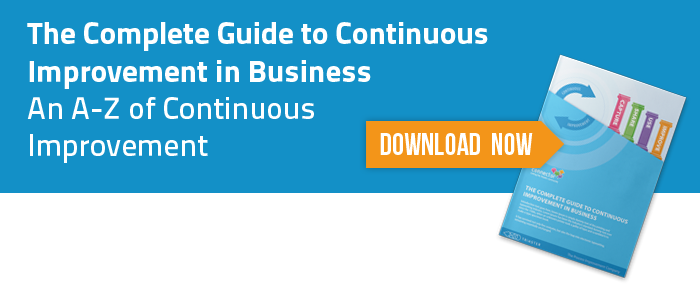Six Sigma, Lean and Kaizen are continuous improvement methodologies that owe their origins to process improvement initiatives in the Japanese and American manufacturing industries of the 20th Century. However, while all three have some similarities, all three have their own part to play in developing an effective business improvement approach.

Contents:
- Six Sigma, Lean and Kaizen: Developing a Continuous Improvement Model That Works for You
- Developing a Kaizen Culture
- Six Sigma
- Lean
- Which Process Improvement Methodology Is Best For Your Business?
Six Sigma, Lean and Kaizen: Developing a Continuous Improvement Model That Works for You
When surveying the contemporary business improvement landscape, it can be difficult to choose which process improvement method (or methods) fit best for what you are trying to achieve. As there are many competing methodologies out there, I have included three of the most respected and popular (Six Sigma, Kaizen and Lean) continuous methodologies to share with you.
Developing a Kaizen Continuous Improvement Culture
Kaizen is a Japanese word meaning 'change for the better' and is also known as 'continuous improvement'. It is a mindset or philosophy rather than being a tool for use.
Essentially, Kaizen is a belief that everything can be changed and everything can be more efficient. Creating a Kaizen culture entails using personal ingenuity to identify and solve problems in an organisation. The strategy aims to collect knowledge from all employees within an organisation to accomplish incremental improvements on a regular basis. What matters is not only the individual, but rather the collective whose collated achievements will be greater.
Kaizen is based on a number of principles, namely:
- Good processes bring good results
- Go see for yourself to grasp the current situation
- Speak with data, manage by facts
- Take action to contain and correct root causes of problems
- Work as a team
- Kaizen is everybody’s business
One of the most prominent Japanese words associated with Kaizen is 'Muda'. 'Muda' means waste, and the Kaizen philosophy aims at cutting business waste through improving quality, increasing efficiency, reducing overproduction and unnecessary activities. Ultimately, this will result in saving both money and time.
Kaizen's core philosophy implies that involving everyone in making decisions will facilitate innovation and improvement. In short, this continuous improvement strategy can be a very powerful support for any improvement project, for as long as the majority of employees are on board.
Six Sigma
Six Sigma is a set of tools and strategies that were created to limit defects and variability.
It has two project methodologies:
- DMAIC (Define-Measure-Analyse-Improve-Control)
- DMADV (Define-Measure-Analyse-Design-Verify)
These two project methodologies are based on Deming's Plan-Do-Check-Act cycle (as previously mentioned) which has become the foundation for continuous quality improvement.
When using Six Sigma, a team leverages advanced statistical techniques such as pareto charts and root cause analysis to reach quantified value targets.
Lean
Lean is focused on the removal of waste and it defines waste as anything that fails to add value to the customer. Its focus on cutting business waste is the Lean methodology's main driver of continuous improvement. Lean particularly revolves around the 7 wastes that are killing business efficiency, namely:
- Transport
- Inventory
- Motion
- Waiting
- Overproduction
- Over Processing
- Defects
Lean owes its origins to the ingenuity of the Ford Motor Company more than 100 years ago and has continued to evolve over time as business improvement concepts have also improved over time. Rather than overcomplicating things, this continuous improvement methodology aims at completing three main steps:
- Identification of wasteful activities
- Identification of the ways these wastes are killing business efficiency
- Elimination or reduction of these wasteful activities
Which Process Improvement Methodology Is Best For Your Business?
Kaizen tries to improve the business as a whole by creating a standard way of working, increasing efficiency and eliminating business waste.
Six Sigma is more focused on quality output (the final product). This is facilitated through finding and eliminating the causes of defects.
Lean is all about eliminating waste to increase process speed and quality through the reduction of process waste.
All three have their part to play in developing effective continuous improvement model and all three can be used in conjunction with one another depending on the specific problem you need to solve.
For more on continuous improvement please download The Complete Guide to Continuous Improvement in Business a full exploration of Continuous Improvement and how to make it business as usual.
Related Articles:
How do I create a culture of Continuous Improvement?
What is Lean Six Sigma? Tools for Process Improvement
10 Ways to Reduce Waste With Lean Continuous Improvement
What are the 7 Wastes That are Killing Business Efficiency?
DMAIC Process vs Cycle: Why Process Wins Every Time
Related White Papers:
The Complete Guide to Continuous Improvement in Business
The Business Improvement E-book
This is an updated and refreshed edition of an article originally written in 2018.
Written by Michael Cousins
Mike founded Triaster in 1994. A thought leader in business improvement, he has led Triaster ever since, spearheading its development of beautifully engineered business improvement software, that is both full of the functionality required by business analysts and that end users find really easy to use.

